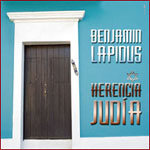Home » Jazz Articles » Album Review » Benjamin Lapidus: Herencia Judia
Benjamin Lapidus: Herencia Judia
Lapidus' expertise is featured on the tres, a small three string Spanish guitar. The basis of this album arose from his explorations of a familial and musical Spanish Caribbean connection. In addition to dealing with Jewish communities in Cuba, Columbia and Puerto Rico and being in touch with his family members scattered throughout the Caribbean, Lapidus envisioned a project that would combine Afro-Caribbean culture with Jewish liturgical works without having to sacrifice either of the two.
The resulting album is indeed an ear-opening and irresistible sense of unification of these two musical forms. Choosing material from the Jewish calendar, Lapidus exposes holiday songs that reflect the joy of the specific occasion as well as the solemnity of the required self-sacrifice. The opening track is the familiar hymn "Ein Kelokeinu," which is usually sung at the conclusion of religious services. Rather than treating it reverentially, Lapidus arranges it in the Puerto Rican bomba dance style and sings the lyrics in Ladino. American mandolin master Andy Statman is on hand to supply his musicianship in areas that are neither bluegrass nor klezmer (his usual métier).
On the title tune, Lapidus sings in both Hebrew and Spanish while "Etz Chaim" is a bembe dance form which utilizes Spanish chekeres. "Aleinu L'Shabeach," nominally a concluding prayer, is performed rumba-style and utilizes the ancient yambu form that provides the drumming from wooden crates. One is reminded of the early career of percussionist Mongo Santamaria during his days on Fantasy Records doing the same thing.
A good portion of this album conveys both the joy and solemnity of the Jewish Holidays. The familiar "Dayenu," a song from Passover, uses the Puerto Rican panderatas frame drums and Lapidus' own singing to convey the complex lyrics and insistent rhythm. Likewise, a version of "Ma Nistana," for the same holiday; uses a changui dance style. On the upbeat "Son de Hanukah," Lapidus delivers an instrumental version of three holiday children's songs, a showcase for the bongo playing of Tony de Vivo. Lapidus goes outside of the Jewish holiday songs for the self-penned "Kaddish Para Daniel," a song for the slain American journalist, Daniel Pearl.
There are many other titles that deserve explanation as well as mention of the many musicians who participated on this session including percussionist Ogduar Roman Diaz, and special guests Oscar Onoz (trumpet), Jeremy Brown (violin) and Onel Mulet (woodwinds), in addition to Statman and percussionist Antonio de Vivo.
If the listener has an affinity for both of these music forms, it is virtually impossible to digest Lapidus' vision within one sitting.
Track Listing
Ein Kelokeinu; Herencia Jud?-a; Etz Chaim; Aleinu L'Shabeach; Las Cuatro Preguntas; Los Cuatro Hijos; Dayenu; Limpieza Jud?-a; Son de Hanukah; Ma Nishtana; Na'anu'im; . Kaddish para Daniel; Tzadik Katamar; Comparsa de Simchat Torah.
Personnel
Benjamin Lapidus
guitarJorge Bringas: bass, vocal (1, 2, 4, 6, 9, 12); Jeremy Brown: violin (13); Antonio de Vivo: percussion, voice (1, 2, 4, 6, 9, 12); Roman Diaz: percussion, voice(5, 11); Benjamin Lapidus: tres, accordion, minor percussion, voice (2, 4, 9, 12); Samuel Levine: maracas (10); voice (1, 3, 4, 6, 7, 12-14); Onel Mulet: saxophone (3,14); flute (13), maracas (9); Oscar Onoz: trumpet(2); Andy Statman: mandolin (1, 6).
Album information
Title: Herencia Judia | Year Released: 2008 | Record Label: Self Produced
< Previous
Ari Erev: About Time
Next >
Bill Mobley: Moodscape
Comments
About Benjamin Lapidus
Instrument: Guitar
Related Articles | Concerts | Albums | Photos | Similar ToTags
For the Love of Jazz
 All About Jazz has been a pillar of jazz since 1995, championing it as an art form and, more importantly, supporting the musicians who create it. Our enduring commitment has made "AAJ" one of the most culturally important websites of its kind, read by hundreds of thousands of fans, musicians and industry figures every month.
All About Jazz has been a pillar of jazz since 1995, championing it as an art form and, more importantly, supporting the musicians who create it. Our enduring commitment has made "AAJ" one of the most culturally important websites of its kind, read by hundreds of thousands of fans, musicians and industry figures every month.



















